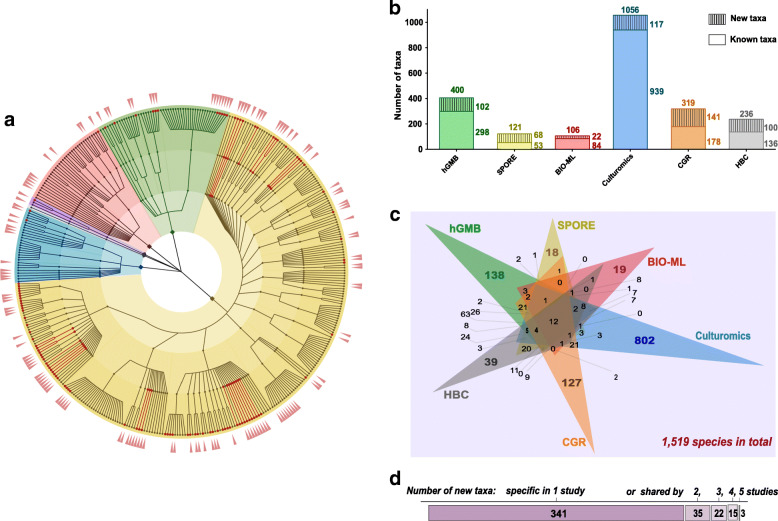Fig. 1.
The taxonomic diversity and specificity of hGMB. a The taxonomic cladogram displaying the taxonomic diversity of hGMB. The nodes of 102 newly characterized species, 28 novel genus and 3 novel family are indicated in red. The background is color-coded according to 6 phyla, yellow: Firmicutes, green: Bacteroides, red: Proteobacteria, blue: Actinobacteria, gray: Fusobacteria, purple: Verrucomicrobia. The outer ring (the coral red pointers) shows the unique 138 species that are solely covered by hGMB. b The taxonomic diversity of gut microbes from different gut microbial collections. hGMB (this study): a human gut microbial culture collection constructed in this study contains 400 species with 102 novel taxa; SPORE [23]: a human gut microbial culture collection constructed in 2016 comprises 121 species including 68 novel-taxon candidates; BIO-ML [21]: a human gut microbial culture collection constructed in 2019 comprises 106 species with 20 novel-taxon candidates; Culturomics [25]: the culturomics study of human gut microbes in 2016 reveal the discovery of 1056 species including 247 novel taxa, of which 117 were still novel-taxon candidates by the time of manuscript preparation; CGR [20]: a human gut microbial culture collection constructed in 2019 comprises 319 species determined based on the 16S rRNA gene sequence clustering at identity of 98.7%, of which 141 taxa are novel-taxon candidates; HBC [24]: a human gut microbial culture collection constructed in 2019 contains 236 species with 100 novel-taxon candidates. c The Venn diagram displaying the unique and shared taxa in each study. The numbers of taxa uniquely in one collection or shared by different studies are labeled in the panel. d Summary of novel taxa claimed by 1 or more than 1 study. Numbers in the bar represent the number of novel taxa. Note: The taxonomic diversity of each previously published study compared in panel b and c was re-mined and summarized as described in “Methods,” and by the time of this writing, all the mentioned “novel-taxon candidates” are never described

